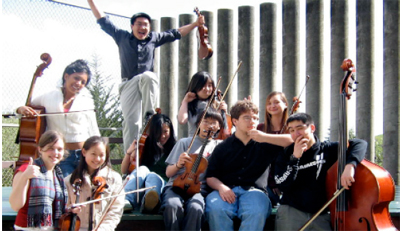 Lincoln Center Festival presented last night the North American premiere of George Benjamin’s first opera, Into the Little Hill. Hill tells a version of the “Pied Piper of Hamelin” story, wherein a mysterious stranger drives the rats from an infested town with his beguiling music. When the mayor reneges on his promise to pay him, the stranger kidnaps the mayor’s little daughter. Martin Crimp’s libretto assigns all roles – the stranger, the mayor, the mayor’s wife, the little girl, the crowd, and the narration – to two singers, a soprano (Anu Komsi) and a contralto (Hilary Summers).
Lincoln Center Festival presented last night the North American premiere of George Benjamin’s first opera, Into the Little Hill. Hill tells a version of the “Pied Piper of Hamelin” story, wherein a mysterious stranger drives the rats from an infested town with his beguiling music. When the mayor reneges on his promise to pay him, the stranger kidnaps the mayor’s little daughter. Martin Crimp’s libretto assigns all roles – the stranger, the mayor, the mayor’s wife, the little girl, the crowd, and the narration – to two singers, a soprano (Anu Komsi) and a contralto (Hilary Summers).
Benjamin and Crimp subtitle their work a “lyric tale,” a label that captures well the unusual storytelling. In that the singers switch between first and third-person points of view, and that each singer inhabits four different “roles,” Hill places considerable distance between us and the drama. If the result lacks emotional impact, the work is nonetheless fascinating and satisfyingly odd. Benjamin’s spare, clear music complements the literary high-jinks of the libretto by providing a sophisticated, cerebral setting of what is essentially an innocent fairy tale. While a certain awkwardness does emerge when the little girl sings tenderly about the rats, the apparent mismatch between style and story actually succeeds overall, because the aim of Benjamin and Crimp is less to make us sympathize with the characters on stage than to make us contemplate their fate.
Given the many complexities of the work, the 40-minute running time, though impractical from other points of view, is a smart musical decision. Hill moves steadily and never overwhelms us conceptually or musically. Midway, a haunting bass flute evokes the Piper’s music, and a cimbalom adds a magical touch to many passages throughout. Anu Komsi has about the most extraordinary high register a composer could dream of, and Hilary Summers’s stage presence is as sharp as her voice is dusky. The austere blocking and set design are of a piece with the musical and dramatic conception.
Before the opera, members of the Ensemble Modern performed Benjamin’s Viola, Viola and Three Miniatures. The viola duet of the first work anticipated the vocal duet that is Hill, and the third of the miniatures uncannily foreshadowed – in its long lines and pizzicato – the concluding passages of the opera.
Into the Little Hill receives performances again tonight and tomorrow, and, if you’re around, I’d recommend going.


 From today’s
From today’s